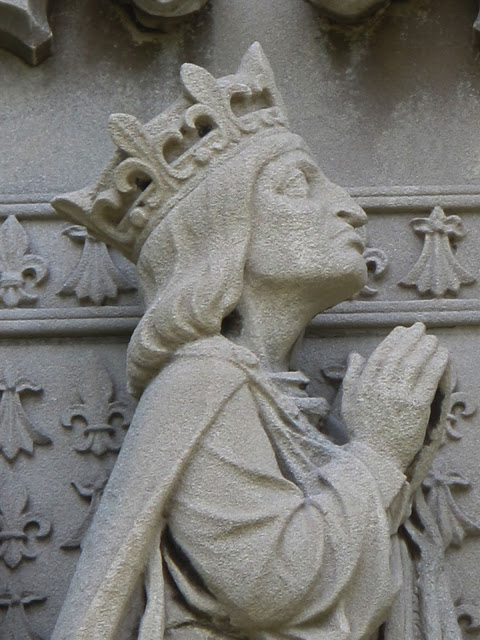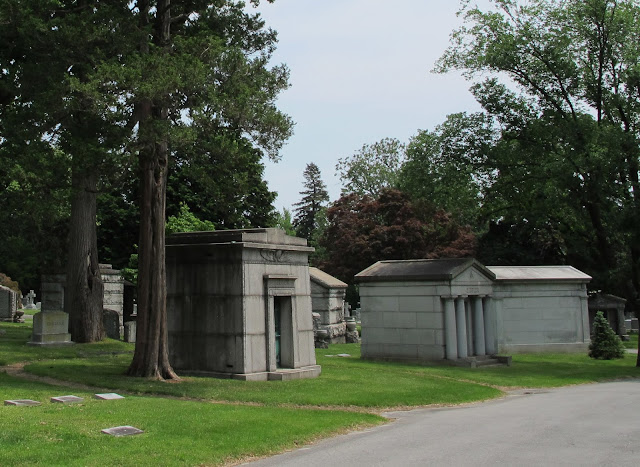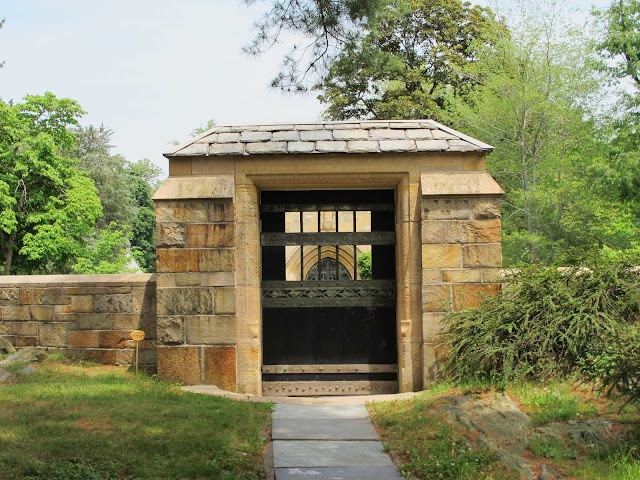If you're a regular reader of Big Old Houses (and I sincerely hope that you are), you'll immediately recognize Lyndhurst (seen above), the astonishing "American Gothic" castle located in Tarrytown, New York, completed in its present condition in 1865. The celebrated (by architectural historians, anyway) Alexander Jackson Davis designed it, but it is better known for the villainous Wall Street manipulator who bought it in 1880, Jay Gould.
After Mr. Gould's death in 1892, first his daughter Helen, and then her younger sister Anna (who became the Duchess of Talleyrand-Perigord) continued to own the house until 1961. That's the duchess, clutching her little dog after a prudent departure from Paris on the eve of the Second World War.
Here's the girls' brother, George Jay Gould, virtuoso of the "wrong step" in everything from business to marriage to real estate. Frank Crowninshield's amusing 1908 book, "Manners for the Metropolis," warns social aspirants (tongue in cheek, OK?) to beware a certain category of acquaintances who are, as he puts it, "on the green, but not dead to the hole." That was George Gould, all right, and you could say the same about his spectacular house, Georgian Court, whose gates and garden facade are illustrated below. It's in Lakewood, New Jersey, a fleetingly fashionable resort deserted by society types with (as we say in real estate) rockets on their butts many (many) years ago. Both Lyndhurst and Georgian Court have been explored in depth in earlier columns. The topic of today's post is: Where are the people who owned them today?
The answer is Woodlawn Cemetery in the Bronx, the greatest necropolis in America and (maybe) in the world. Three hundred thousand people, among them "Le tous" New York Society, share 400 acres of rolling hills, shimmering lawns, specimen trees and, in certain swankier districts, a stunning total of 1,271 private mausoleums, ranging in design from the merely expensive to the historically important. Woodlawn was founded in late 1863, the first "loved one" lowered into the earth in January of 1865. It caught fire with the plutocracy after the 1884 construction of the Gould family mausoleum, designed by one Hamilin French, an architect of whom I've never heard. Funny isn't it? Although loathed by the general public, the construction of Gould's mausoleum ignited a fashion for the cemetery. (Maybe understandable, if you think about it). The weeping beech beside the mausoleum is now bigger than the building itself. I wanted to go inside, but the key didn't work.
Also at Woodlawn are former owners of another of my big old houses, Belcourt in Newport, R.I. They are Oliver Hazard Perry Belmont, charming son of Rothschild represent August Belmont, and his redoubtable wife, Alva. Mrs. B was many things - builder of palaces from Fifth Avenue to Newport, brave divorcee (from W.K. Vanderbilt, at a time when divorce was social suicide), braver champion of women's rights, and the mother who forced her daughter to marry the Duke of Marlborough. Her reasons for the latter were actually quite sound but, as all of us must learn (hopefully sooner than later), we must let our children make their own mistakes. Richard Morris Hunt, who designed 660 Fifth Avenue and Marble House in Newport for Alva, also designed Belcourt for her husband in 1894, before the Belmonts' marriage. Their mausoleum at Woodlawn is an immodest miniaturization of the chapel of St. Hubert in Amboise, France, designed by Hunt's sons in 1908.
Alva Belmont, erudite student of Gothic art and a great one for fitting out her many houses with Gothic Rooms, was clearly the guiding hand behind Hunt and Hunt's design. Some years ago, a clever Woodlawn intern announced that the praying figure above the front door was actually Mr. Belmont. The story has currency to this day. Had that intern also been clever enough to look at pictures of Mr. Belmont, he would have realized the statue looks nothing like him. Considering Alva's mad preoccupation with Gothic accuracy, it might well depict some actual historical character from the middle ages. But her husband, it ain't.
Here are Jonathan and Harriet Thorne, presently horizontal residents of Woodlawn, but formerly builders of another subject of my column, 1028 Fifth Avenue. The Thorne family has a railed plot, as opposed to a mausoleum, and within it rest numerous generations with room for numerous more. I'm assuming Mrs. Thorne is in here somewhere, but I forgot to look for her. (I'm bad).
There are two main entrances to Woodlawn. This one is on Jerome Avenue, a little south of East 233rd Street, practically facing the last station on the #4 train. Yes, you can take the subway to Woodlawn. The second entrance is on the opposite side of the cemetery, at the corner of 233rd Street and Webster Avenue, across from the Woodlawn stop on Metro North. Proximity to the railroad (tracks were laid in 1865) vaulted Woodlawn over its great competitor, Green-Wood Cemetery in Brooklyn. You could take a train to the former from 42nd and Park, as opposed to fighting downtown traffic and taking a ferry across the river to the latter. After 1871 you could even rent a special Woodlawn car at Grand Central, to whisk loved one and mourners alike directly to the Webster Avenue gate.
Very early on, in 1867, Woodlawn adopted the so-called "landscape-lawn" plan which, the Thorne plot notwithstanding, substituted circular plots and a serpentine road plan for the usual right-angled geometry and abundant fencing of most cemeteries to that date. Woodlawn was - and still is - a for-profit undertaking, continued improvements to which included a fashionable replacement of the Jerome Avenue gate in 1915. You might think of Woodlawn as a sort of enormous coop, whose Cemetery Corporation owns the land and collects a form of maintenance from individual Cemetery Association members, each of whom who can build whatever he wants on his designated plot. In 2011 Woodlawn became a National Historic Landmark. So far none of the major mausoleum owners has attempted any architectural bollixing, and let's hope none does.
You could loop around this place for hours, in part because roads followed in one direction look completely different when followed in another. Plus which, it's typical to admire some stunning vista of weeping angels, towering obelisks, specimen trees, etc., etc. without realizing you've already looked at it from three other angles.
I will spare you Woodlawn's list of important architects and sculptors, which you probably wouldn't remember, and limit myself instead to a short "statue tour."
Not every business heavyweight or society leader was buried so magnificently. Birdie (Mrs. Graham Fair) Vanderbilt, owner of the beautiful French mansion at 60 East 93rd Street seen below (one of my BOH favorites), rests beneath a comparatively simple bench.
Society leader Percy Rivington Pyne, builder of 680 Park Avenue, lies beneath a simple slab in a sort of sacred grove. Part of this simplicity may stem from the fact that Mr. Pyne died 60 days before the stock market crash of 1929, which fact did not deter the powers that be from taxing his estate at its pre-crash value.
I wanted to check out three more individuals whose houses appeared on Big Old Houses. We'll take the scenic route to the first.
This fierce looking individual was Henry H. Cook, a prototypical Victorian macher who summered at Tanglewood (today's warm weather home of the Boston Pops), and kept a big and not particularly beautiful house on Fifth Avenue and 78th Street. He was the man who developed the famous Cook Block, located between Fifth, Madison, 78th and 79th Streets, whose original restrictive covenants, despite no longer being in force, have managed to preserve the grandest and most intact mansion block on Manhattan. Cook's house was replaced in 1912 by Horace Trumbauer's palace for tobacco baron James B. Duke.
William Sloane, of the W. & J. Sloane furniture emporium family, hired society architects Delano & Aldrich to build Merestead in the country and 686 Park Avenue in town. The Sloane family mausoleum looks a sight better indoors than Mr. Cook's.
The last (and possibly the richest) of those persons whose houses I've written about, is Standard Oil heir Edward Harkness, seen below with his wife Mary. James Gamble Rogers designed the Harkness house in New York, at 75th and Fifth, as well as the mausoleum below, whose walled garden was designed by Beatrix Farrand. Woodlawn's elaborate funerary architecture was originally complimented by equally elaborate landscaping, much of which has disappeared from lack of maintenance. The Harkness plot is an exception.
The people I've written about in Big Old Houses belonged to an important group at Woodlawn, but they constitute a small - if highly visible - fraction of the cemetery's total number of "loved ones." Somewhere on these 400 acres is an example of pretty much every style of monument you can think of, sitting on top of a whole lot of people you've heard of, and a whole of others you haven't.
Did you know that Herman Melville is buried at Woodlawn? So is Thomas Nast, Joseph Pulitzer, Irving Berlin, Admiral Farragut, Fiorello LaGuardia, Robert Moses, Duke Ellington and the Queen of Salsa, Celia Cruz. The biggest private plot covers six and a half acres; the smallest accommodates a simple slab with enough room to walk around it. Some people, like Col. William Boyce Thompson who, together with the staircase in his beautiful Yonkers mansion is illustrated below, built a mausoleum, had a change of heart, and sold it to someone else. Thompson sold his to a Brooklyn resident named Ernest Arata.
For years I've been telling people they'd be amazed by this place. My visit today was a result of a call from Eline Maxwell at the Woodlawn Conservancy, suggesting I write about it for Big Old Houses. Good idea; I'm glad I did.



























































































